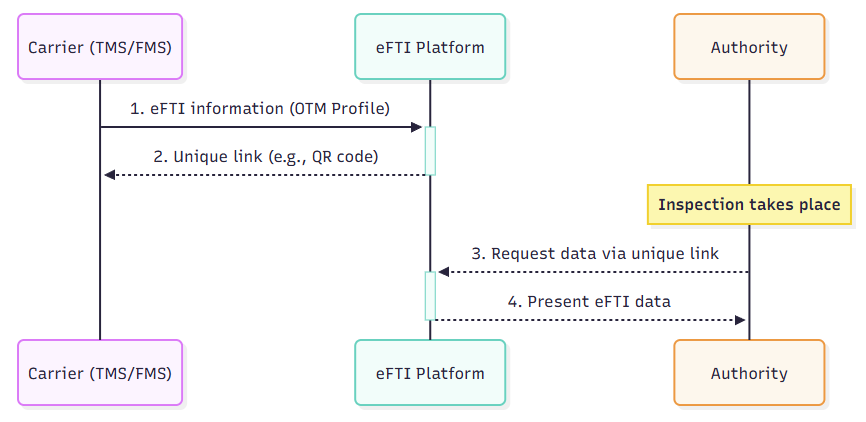OTM Profile - eFTI
This profile is still a work in progress.
The message models of OTM profiles are specified and maintained here: https://sutc.semantic-treehouse.nl/specifications
Direct link to the DRAFT version: OTM Profile - eFTI
Introduction / context
The eFTI Regulation (Regulation (EU) 2020/1056) sets the rules for sharing digital transport information between businesses and enforcement authorities. Simply put, it ensures that a digital consignment has the same legal status as its paper equivalent throughout the EU, and that authorities are required to accept it. This gives companies the right and opportunity to go digitalize their processes, which reduces paperwork and costs.
This electronic exchange happens through certified eFTI platforms. A company sends its transport data to an eFTI platform, and when an inspection occurs, the driver can simply show a QR code to grant the authority access.
To help deliver this consignment data to these platforms, the eFTI OTM profile has been developed. Where the eFTI regulation defines the legal data requirements (the "what"), the OTM profile helps to structure and standardize this information for the exchange (the "how"). This saves developers from the complexity of interpreting the legislation themselves and handling the data delivery to these eFTI platforms.
Scope OTM Profile
To share transport information digitally, businesses (e.g., carriers) must use a certified eFTI platform. Such a platform, often operated by a certified eFTI service provider, acts as a secure and trusted gateway between the business and the enforcement authority.
To help developers automate the delivery of data to these platforms, this OTM profile has been developed. It standardizes the information exchanged from the carriers's IT system (such as a TMS) to the eFTI platform. After the data is submitted, the platform generates a unique link (often as a QR code) that the driver can present during an inspection. All authorities in the EU member states are obliged to accept information provided via a certified eFTI platform.
The diagram below shows the information flow and where the eFTI OTM profile fits in.

Everything that happens after the data is delivered (from step 2 onwards) is out of scope for this profile. Our focus is only on standardizing the data delivery from the carrier to the platform (step 1).
Foundation for eFTI profile
The eFTI OTM profile is based on the information requirements identified by Topsector Logistiek. In preparation for the eFTI regulation, Topsector Logistiek has analyzed the legal texts and technical specifications to determine the exact data elements required for digital reporting to authorities.
This analysis forms the direct basis for the structure and content of this OTM profile. When translating these requirements into an OTM profile, an effort was made to align as much as possible with the existing Open Trip Model (OTM). However, it is possible that not all necessary data elements can be directly mapped one-to-one onto the current OTM. This may lead to proposed changes or extensions to the core OTM model in the future.
The detailed information requirements, as established by the Topsector Logistiek, can be found here: TSL introduction eFTI.
OTM Profile Strucutre
The eFTI profile specification can be found in our Semantic Treehouse environment.
The profile is modeled according to OTM principles. As a root element it uses the OTM root element Trip. This container element contains the following sub-elements: Actors, Actions, Vehicle. The information contained in actors is used to describe all parties involved in the transport process. The information in actions is used to give some general information about the trip that is performed by the actors, and the information in vehicle is used to describe the vehicle used in the transport process.
Relation to other standards
The eFTI regulation is a framework that governs the digital exchange with authorities for various legally required transport documents. It does not replace the underlying standards (such as this OTM profile) for those transport documents but only ensures their digital acceptance. Note that there might be other international standards for the eFTI information, such as:
- e-CMR: The data elements of an e-CMR are a subset of the eFTI dataset.
A key consideration is how these standards (OTM and e-CMR) relate to each other and how to manage their overlap.